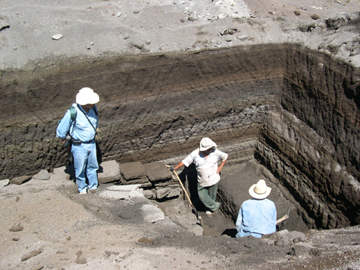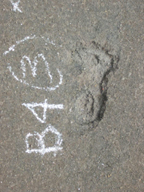
 Traditionally,
scientists have thought that people probably first migrated to North America
via the Bering land bridge just over 11,000 years ago, based on human artifacts
of that age found first near Clovis, N.M., and then throughout the West. Since
the 1970s, however, when several older archaeological sites, including the 12,500-year-old
Monte Verde site in Chile, were discovered, some scientists have wondered whether
people arrived earlier. Now, a newly found set of human footprints in Mexico
is suggesting that people were in the Americas much earlier than previously
thought — 30,000 years earlier.
Traditionally,
scientists have thought that people probably first migrated to North America
via the Bering land bridge just over 11,000 years ago, based on human artifacts
of that age found first near Clovis, N.M., and then throughout the West. Since
the 1970s, however, when several older archaeological sites, including the 12,500-year-old
Monte Verde site in Chile, were discovered, some scientists have wondered whether
people arrived earlier. Now, a newly found set of human footprints in Mexico
is suggesting that people were in the Americas much earlier than previously
thought — 30,000 years earlier. In the Valsequillo Basin in Mexico, geoarchaeologists discovered 269 individual footprints of humans and animals. The human footprints (inset) preserved impressions of the toes and of where the heel and ball of the foot meet. Courtesy of Matthew Bennett.
“Even a find of 13,000 years would have stirred up controversy,” says Rolfe Mandel, a geoarchaeologist at the University of Kansas, so there is bound to be a lot of skepticism about the Mexican site. “This discovery is really going to shake up how archaeologists think about the peopling of the Americas, both temporally and spatially.”
In summer 2003, researchers Matthew Bennett of Bournemouth University and Silvia Gonzalez and David Huddart of Liverpool John Moores University in the United Kingdom were dating and mapping the geology of the Valsequillo Basin in Mexico, about 130 kilometers south of Mexico City, when they came across what appeared to be footprints on the floor of an abandoned quarry. Examining the site further, they found the site littered with footprints, Bennett says — 269 individual prints of humans and animals intermingled.
Sixty percent of the footprints appear to be human, with telltale arches and impressions of the heels, balls and toes, and 36 percent of those appear to be child-sized, according to the researchers, whose work is in press in Quaternary Science Reviews. The remaining 40 percent of the prints were from a variety of animals, Bennett says, including dogs, big cats and animals with cloven hooves, such as deer and camels. The researchers also found mastodon and mammoth teeth.
Previously, in the 1960s and 1970s, archaeologists found megafaunal remains, including bones that had been “worked” with tools, scattered throughout the basin. Those remains had been unreliably dated to be between 20,000 and 40,000 years old, Bennett says, so the sites have been somewhat ignored since then.
The footprints are preserved in a layer of volcanic ash from the eruption of Cerro Toluquilla beneath a shallow lake in the Valsequillo Basin just over 40,000 years ago. “Volcanic ash lithifies quickly, like cement,” Bennett says, so when the inhabitants of the lake shores wandered across the mucky ash, their footprints were captured. When lake levels later rose, water washed over the footprints, burying them in lake sediments, he says. “So we have this great stratigraphic sequence” of lake sediments, topped by ash, which is then topped again by lake sediments, Bennett says, that can be dated.
The researchers sent samples from the site, including of the ash, mollusk shells and mammoth molars, to dating experts at the University of Oxford Research Laboratory for Archaeology and the History of Art. The Oxford team used three different methods to determine the dates of the sediments above and below the footprints layer, as well as the ash layer itself. The dates all agreed, Bennett says, putting anatomically modern humans in the Americas more than 40,000 years ago.
It is “rare to have such bounding dates” for archaeological sites and such good preservation of trackways, Mandel says. “This is an astonishing find,” he says, “and the dates look solid.” Because the leap of time from the Clovis sites to the footprints in Mexico is so large, he says, researchers might need to consider migration routes other than via the Bering land bridge, and reconsider archaeological sites that have been previously dismissed.
But Michael Waters, a geoarchaeologist at Texas A&M University in College Station, is not convinced. He says that the ash layer is likely much older than 40,000 years, and should be retested using different methods. Furthermore, says Waters, who has visited the site, “I have serious reservations as to whether or not these are even footprints, human or animal.” The site has been so extensively quarried over the years, being chopped with axes and picks, that these imprints could just be tool marks that have weathered.
The team, Waters says, needs to find tracks in outcrops or areas that have not been quarried — “look for them like you would look for dinosaur or other trackways.” Bennett says that he and his colleagues are planning to begin just such excavations soon.

